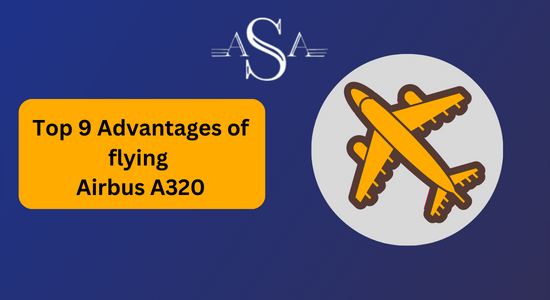9 Advantages Of Flying Airbus A320
- August 22, 2023
- 3:03 pm
- No Comments

After successfully introducing the A300, Airbus aimed to establish a strong presence in the single-aisle aircraft market, competing against Boeing 737 and McDonnell Douglas’s DC-9. Airbus needed an exceptional product to capture attention and market share, leading to the development of the Airbus A320, which became the first aircraft in the prevalent single-aisle family.
The original A320 brought several revolutionary features, including side-stick flight controls, a fly-by-wire system, and cargo capabilities. The A320 family expanded, including the A318, A319, and A321 models, and further evolved into the A320neo family over the course of time. It is a popular commercial airliner known for its narrow-body design and twin engines. It can accommodate 150 to 180 passengers, depending on its specific configuration. The A320 family includes various models, including the A320-100, A320-200, A320neo, and A321.
With its advanced glass cockpit, the A320 features digital displays, fly-by-wire controls, and avionics systems like the Flight Management System (FMS) and Electronic Flight Instrument System (EFIS) that contribute to safety and efficiency. The aircraft ranges from approximately 3,300 to 3,700 nautical miles, gliding at around Mach 0.78. It even provides a comfortable cabin with customizable interiors, ample storage, and a strong safety record leading to commercial success while competing with the Boeing 737 series in the short- to medium-haul market and serving various domestic and international routes. Airlines value its efficiency, versatility, and passenger comfort, making it a preferred choice in the industry.
Let’s soar high into the nine advantages of flying the Airbus A320:
1. Fuel Efficiency: The A320 is revered for its fuel efficiency, leading to significant cost savings for airlines. It incorporates advanced aerodynamic design and lightweight materials, resulting in lower fuel consumption per passenger than older aircraft models. The aerodynamic design of the A320 contributes to its fuel efficiency. It features slim wings and wingtip devices called winglets, which reduce drag and overall resistance to the air, thus improving fuel efficiency. Airbus utilizes lightweight composite materials in constructing the A320’s structure, including the wings and fuselage. These lightweight materials help reduce the aircraft’s weight, leading to lower fuel consumption. The technologies used in A320 optimize the aircraft’s performance and fuel consumption by calculating the most efficient flight paths, speeds, and engine settings. Airbus continually invests in research and development to enhance the fuel efficiency of their aircraft. The A320neo series, for instance, introduces additional aerodynamic improvements, engine enhancements, and other technological advancements to achieve even better fuel efficiency than previous A320 versions.
2. Range: The A320 family of aircraft offers a range of options to meet different airline needs. It can comfortably cover medium-haul routes, while the A321 has an extended range and can handle longer flights. This flexibility allows airlines to efficiently serve a wide range of destinations as the A320 is a famous commercial aircraft manufactured by Airbus. Its range can vary depending on several factors, including the specific model variant, payload, weather conditions, and operational considerations. The range of the aircraft can differ slightly due to fuel efficiency and engine performance variations. The A320-200 has a typical range of around 3,300 nautical miles (6,100 kilometres) when fully loaded with passengers and cargo. The A320neo models offer improved fuel efficiency and increased range. It has a range of approximately 3,400 nautical miles (6,300 kilometres), while the A321neo, a larger variant, can fly up to 4,000 nautical miles (7,400 kilometres). These approximate figures can vary depending on specific configurations and operating conditions. Airlines may also have different fuel load and payload considerations that can affect the aircraft’s range on a particular flight.
3. Passenger Capacity: The A320 is designed to accommodate many passengers while maintaining comfort. The typical A320 configuration can seat around 150-180 passengers, depending on the airline’sairline’s preference. The A321, with its larger fuselage, can carry even more passengers than the typical passenger capacity of an Airbus A320 aircraft in a standard two-class configuration. However, this can vary depending on the airline’s seating arrangement and cabin layout preferences. Some airlines may configure the aircraft with a single-class layout, which can accommodate more passengers, while others might allow higher comfort and additional space, resulting in a lower passenger capacity. However, airlines can configure their aircraft according to their requirements so that the exact passenger capacity can vary from one airline to another.
4. Cabin Comfort: Airbus strongly emphasizes passenger comfort, and the A320 reflects this commitment. The cabin has ergonomic features, spacious overhead bins, and wide seats to enhance the passenger experience. The aircraft also boasts large windows, allowing more natural light into the cabin. The level of comfort in the cabin of an Airbus A320 flight can vary depending on the airline and how the aircraft is configured. However, It’s important to note that the specific cabin comfort experience can differ between airlines, as they have the flexibility to customize the interior of their A320 aircraft. Therefore, the exact features and amenities can vary between different A320 flights.
5. Advanced Avionics: The A320 is equipped with advanced avionics and fly-by-wire technology, which enhances flight safety and reduces pilot workload. This aircraft’s technology even imparts accurate and real-time data to the flight crew, assisting them to make informed decisions during the flight. The advanced avionics in the A320 aircraft extensively enhance its flight capabilities and provide pilots with advanced navigation, communication, and automation features. Some examples include the Flight Management System (FMS) that automates navigation and flight planning tasks, the Electronic Flight Instrument System (EFIS) that replaces analogue instruments with digital displays for easy-to-read flight information, and the Autopilot and Autothrust System that automate various aspects of flight to maintain altitude, heading, and speed.
The A320 also features a Fly-by-Wire (FBW) System for smoother flight control, an Integrated Modular Avionics (IMA) architecture for simplified maintenance and improved reliability, an Enhanced Ground Proximity Warning System (EGPWS) for alerting pilots of potential dangers, and Data Link Communication systems for efficient communication with air traffic control. These advanced avionics significantly improve situational awareness, flight safety, and operational efficiency, marking a significant technological advancement in commercial aviation.
6. Noise Reduction: The A320 incorporates various noise reduction measures, such as advanced engine design, improved aerodynamics, and sound-absorbing materials. It helps minimize noise levels inside and outside the aircraft, providing a quieter and more pleasant flying experience. Airbus has tried to minimize cabin noise and vibration in the A320 series. This aircraft is enabled with advanced soundproofing materials and systems to reduce noise levels, providing a more comfortable environment for passengers.
7. Commonality: The A320 family shares a high degree of commonality, meaning that pilots and maintenance crews can easily transition between different variants within the family. This commonality reduces training costs for pilots and streamlines maintenance procedures, leading to operational efficiencies for airlines. It includes standardized features, procedures, and systems across all Airbus A320 aircraft. These common elements are implemented to ensure consistent operations, simplify pilot training, and enhance safety. Key aspects include a uniform cockpit layout across the A320 family, utilization of a fly-by-wire system for consistent control inputs, standardized flight instruments, a standard Flight Management System (FMS) for flight planning and navigation, established operating and emergency procedures, and shared maintenance practices. While minor differences may exist due to specific airline configurations or optional equipment, these variations typically pertain to non-standardized elements and do not significantly impact the overall commonality of A320 flights.
8. Proven Track Record: The A320 has been in service since the late 1980s, accumulating millions of flight hours across different airlines and regions. Its reliability and performance have been proven over time, making it a trusted choice for airlines worldwide. The Airbus A320 is widely used for short to medium-haul flights and has a strong reputation based on millions of flight hours accumulated by various airlines. Since its introduction, the A320 family, including the A319, A321, and A320neo models, has been highly regarded for its reliability, fuel efficiency, and advanced technology. It has demonstrated excellent safety performance and is considered a dependable airline choice. An aircraft’s safety and track record are influenced not only by the aircraft itself but also by the maintenance and operational practices of the operating airline. Airlines follow strict maintenance procedures and safety regulations to ensure the safe operation of their aircraft. Researching the airline’s safety records and incident history is recommended to obtain specific information about an airline’s track record with the A320 or any other aircraft. Regulatory authorities like the FAA, EASA, and national aviation authorities maintain comprehensive databases and reports on aircraft incidents and safety records.
9. Technological Advancements: Airbus continually invests in research and development to improve its aircraft models. The A320neo (new engine option) incorporates the latest engine technologies, such as more fuel-efficient engines and aerodynamic enhancements. This results in further fuel savings, reduced emissions, and improved overall performance. The A320 introduced a fly-by-wire system, where electronic signals transmit pilot inputs to the control surfaces, enhancing flight control and stability. It also features a modern glass cockpit with digital displays, improving situational awareness by replacing traditional analogue gauges.
The advanced Flight Management System automates navigation, performance calculations, and aircraft systems management, optimizing fuel efficiency and providing navigation guidance. An Enhanced Ground Proximity Warning System uses GPS data and terrain databases to warn pilots of potential ground conflicts, enhancing safety during takeoff, landing, and low-altitude operations. The auto thrust system assists pilots in managing engine thrust, maintaining airspeeds, reducing workload, and enhancing fuel efficiency. Additionally, A320 aircraft can use data link communication systems like ACARS to exchange real-time information with ground-based systems for operational purposes.
The Airbus A320’s advantages have made it a preferred choice for many airlines, allowing them to operate efficiently, provide a comfortable experience for passengers, and reduce their environmental impact. Commercially, the A320 family has experienced significant success, with thousands of units delivered to airlines worldwide. It competes with other narrow-body aircraft, such as the Boeing 737 series, primarily in the short- to medium-haul market segment. The A320 is widely utilized for domestic and international flights, serving various routes. Airlines appreciate its operational efficiency, versatility, and passenger comfort, making it a favoured choice in the industry.

